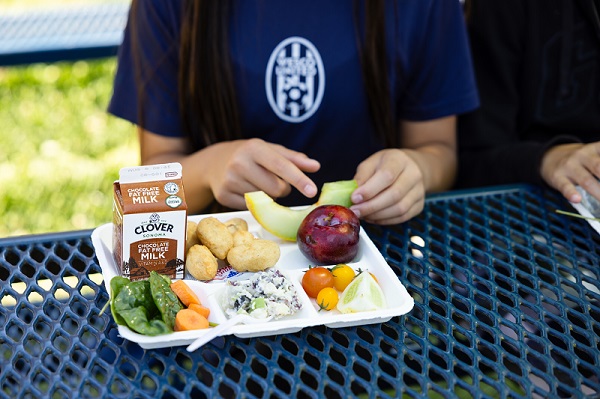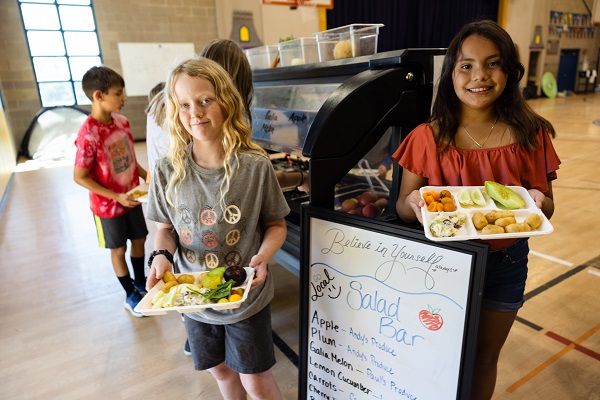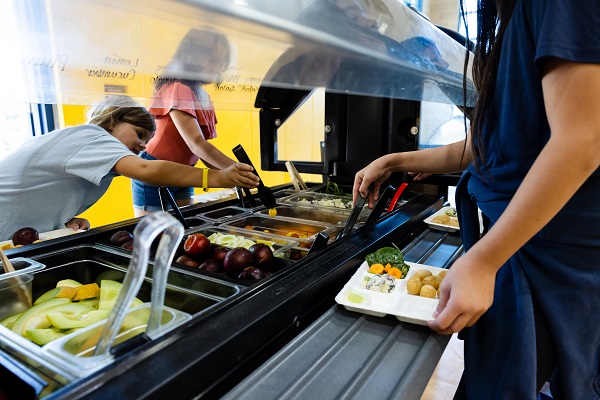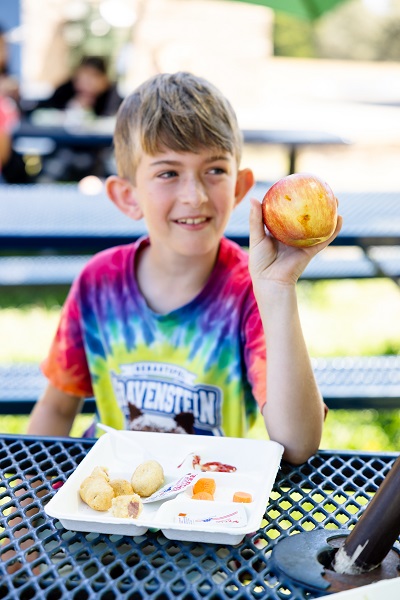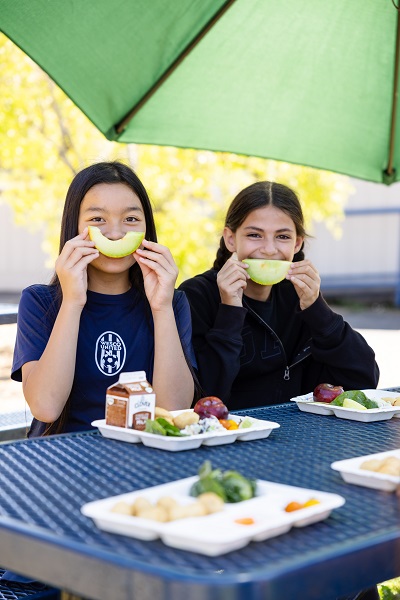How Sonoma County schools are seeking to replace prepackaged vended food with farm-grown produce.
Photos – Paige Green Photography
You are what you eat. And for the 30 million children in the US who rely on a school lunch program, that’s even more true. What these growing kids eat not only impacts their health but also has been proven to impact their grades and long-term well-being too.
And so when Queti Gomez, Nutritional Services Lead at the Gravenstein Union School District (GUSD), found herself reheating processed, anonymous food wrapped in cellophane for a few hundred students, she knew they could do better. Here they were in Sonoma County, “the chosen spot of all the earth,” according to famed horticulturist Luther Burbank, who put this place on the map with what he could grow from its soil, and yet nothing in those little precooked plastic packages reflected the delicious bounty all around us.
“We wanted to give our kids more choices,” she said, “less processed, healthier and more locally grown food. And we wanted to support smaller businesses in our community. Most of all, we wanted to provide a richer quality of life, educating them about different foods. All they ever saw before were a handful of different fruits and veggies: bananas, oranges, apples. But more recently, they got to taste multiple varieties of tomatoes. We’ve had starfruit and pomegranate. And last week, we tasted nopales, cactus!”
That’s because last year, Queti and GUSD joined hundreds of other schools around the state in a growing farm-to-school movement. Ditching their “vended” program (in which a company delivers pre-cooked, packaged meals that meet the bare minimum nutritional standards required by the USDA), they’ve since expanded their kitchen and hired more staff to prepare fresh meals sourced from local farms while debuting a new salad bar featuring an array of fresh ingredients.
Not only do the kids now have more options, healthier food, and a lot more colors on their plate, but the school district actually saved money in the process! With more control and flexibility, they’ve been able to buy only what they need, reduce food waste, and design a program that better fits their circumstances.
That’s not to say the switch was easy. And they’re still in the process of that transition, working out the kinks along the way. Having helped countless schools like Queti’s make this switch, Ben Thomas knows these challenges well. He is the founder of Shared Plate Strategies and formerly worked with the Community Alliance with Family Farmers, an organization that’s been advocating for farm-to-school funding for decades. The biggest hurdle? Navigating government regulations.
Because school lunch programs use public dollars, there’s a complex system of accountability, a bureaucracy just onerous enough to dissuade some school districts from giving up their vended programs. As Ben explains, school districts must ensure “fair and open competition,” meaning they must prove that they’ve made the most economic choices when purchasing ingredients. There are various layers to this process, but in many cases, schools must gather multiple bids from several producers and select the least expensive option. Even if, like in Queti’s situation, the local option turns out to be more affordable, these hoops might be too much for a school overwhelmed by a myriad of other issues, whether that’s improving school safety or meeting the state’s common core standards in math and reading.
This is where Ben and Shared Plate Strategies come in. “We try to simplify what is inevitably a delicate dance when it comes to local procurement,” he said. And lucky for Sonoma County, he and several local partners, including Conservation Works, the School Garden Network and two local resource conservation districts, have recently been awarded a grant from the California Department of Food & Agriculture (CDFA) to spend the next three years strengthening ties between local agriculture and school cafeterias. This grant belongs to a new wave of public funding meant to spur such programs, especially since the establishment of the CDFA’s office of Farm to Fork just a few years ago.
Queti’s school district is just one among 40 in Sonoma County, and a smaller district at that, with an enrollment of only about 750 students, whereas the county in total boasts over 66,000 public school students. Which raises the question: in a region dominated by grapes (and not the kind you might find in Queti’s salad bar), can this region even feed that many students?
Dylan Stein is on a mission to make sure it can. As the wholesale manager at FEED Cooperative, Dylan works with dozens of farms across the North Bay, most of whom grow on only a few acres. Alone, these small family farms would struggle to meet the demand from any one of the county’s bigger school districts, let alone navigate the bureaucracy involved. But together, as member-owners of FEED Cooperative, they’re able to access this nascent market for locally grown school food. The key, says Dylan, is aggregation. In addition to working with Queti, FEED is also working with districts like Healdsburg, Napa Unified, and Rincon Valley Unified.
“The nutritional quality coming straight from a farm is just gonna be better,” says Dylan, “and kids oughta be fed well. They’re the future! Plus, there’s inherent educational opportunities with farm-to-school. We can send them 15 different apple varieties and that’s sure to get kids talking!”
But the most important benefit to Dylan is that the opening of these sales channels can support an entire community of farms, infusing our local economy with money that would otherwise be sent elsewhere. The more demand there is for local food, the more farmers can sustain and grow their operations. In fact, if this surge in local spending keeps up, it might even help new farmers get started—in a time when America loses four farms per day, the average age of farmers nears 60, and Sonoma County’s existing food producers struggle to compete in a fast-consolidating global market.
Unlike big distributors, FEED is committed to transparency. In fact, their entire cooperative is built upon the celebration of its members, the farmers themselves, encouraging consumers to recognize that a carrot is not just a carrot; it’s a particular variety of carrot that’s been grown by a particular person on a particular farm using particular practices. Whereas most government regulated nutritional standards emphasize quantitative measurements (serving size, total calorie intake, the percentage of fat in a milk carton), farm-to-school can offer kids a deeper, more holistic approach to food.
“The role of food in our lives is so much bigger than just keeping us alive as an energy source,” says Courtney Delello, the new Farm to School program manager at the School Garden Network. As part of that grant from CDFA, Courtney is working to bring schools even closer to the farm–in fact, she’s working to bring soil, seeds and irrigation to campuses throughout the county. By providing grants and technical assistance, they intend to help grow school garden programs at 10 public schools over the next two years, giving kids a hands-on look at how food is grown.
Along with digging in the dirt and watering plants, these programs also include culinary education that, according to Courtney, instills a deeper meaning to their food. Whether the kids grew it themselves or learned about the local farm who grew it for them, they come away with a new appreciation. “It brings in culture, spirituality, and the social element of food,” she says.
As for Queti, she’s excited about the new gardens going in at her school. They’ve already got plans for an after-school garden club, and the produce they grow will be incorporated into the cafeteria’s salad bar.
Will their new garden club put the local farms that Queti is currently buying from out of business? Probably not. But given the average age of agricultural operators in this country, perhaps these farm-to-school programs might just grow us a new crop of much-needed farmers.


